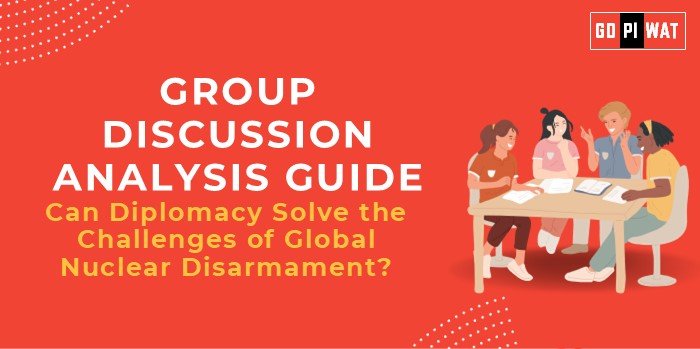📋 Group Discussion (GD) Analysis Guide
🌟 Can Diplomacy Solve the Challenges of Global Nuclear Disarmament?
🌐 Introduction to Global Nuclear Disarmament
Opening Context: “Global nuclear disarmament remains one of the most critical objectives for international peace and security. Despite decades of negotiations, over 12,500 nuclear warheads are still in existence, presenting persistent threats to humanity and the environment.”
Topic Background: Efforts to achieve nuclear disarmament date back to the Treaty on the Non-Proliferation of Nuclear Weapons (NPT) of 1968, which set the framework for reducing nuclear stockpiles. However, geopolitical rivalries, distrust among nations, and emerging nuclear powers continue to impede progress.
📊 Quick Facts and Key Statistics
- 🌍 Global Nuclear Arsenal: Over 12,500 warheads as of 2024, primarily held by the U.S. and Russia.
- 📝 NPT Membership: 191 countries, but key non-signatories include India, Pakistan, and Israel.
- 💵 Nuclear Weapon Spending: $82 billion annually among nuclear-armed states.
- 🛡️ TPNW: Adopted in 2017 but not endorsed by nuclear powers.
👥 Stakeholders and Their Roles
- 🇺🇳 Nuclear-Armed Nations: Key players in disarmament negotiations, often reluctant to forgo strategic advantages.
- 🌐 Non-Nuclear Nations: Advocates for disarmament through treaties like the TPNW.
- 🏢 International Organizations: The UN and IAEA monitor compliance and advocate for denuclearization.
- 🤝 Civil Society Groups: Organizations like ICAN promote public awareness and pressure governments for disarmament.
🏆 Achievements and Challenges
- 🎯 Achievements:
- Arms Control Treaties: START treaties reduced U.S. and Russian arsenals significantly.
- Global Advocacy: ICAN won the Nobel Peace Prize (2017) for its role in advancing the TPNW.
- Nuclear-Free Zones: Over 110 countries have committed to regional nuclear disarmament agreements.
- ⚠️ Challenges:
- Geopolitical Rivalries: U.S.-China and India-Pakistan tensions complicate multilateral agreements.
- Non-Compliance: Withdrawal from treaties like the INF by major powers undermines trust.
- Emerging Nuclear States: North Korea’s continued expansion of its nuclear arsenal.
🌍 Global Comparisons
- 🇿🇦 Success: South Africa voluntarily dismantled its nuclear weapons program in the 1990s.
- 🇰🇵 Failure: North Korea’s nuclear proliferation despite sanctions.
Case Study: The Iran Nuclear Deal (2015) – A temporary diplomatic success curtailed Iran’s nuclear activities but faced setbacks after U.S. withdrawal in 2018.
📋 Structured Arguments for Discussion
- ✔️ Supporting Stance: “Diplomacy has led to significant reductions in nuclear arsenals, as seen with the START treaties.”
- ❌ Opposing Stance: “Diplomacy alone cannot overcome the deep-seated distrust and strategic interests of nuclear powers.”
- ⚖️ Balanced Perspective: “While diplomacy is essential, it must be complemented by enforcement mechanisms and trust-building measures.”
🛠️ Effective Discussion Approaches
- 🔍 Opening Approaches:
- Historical Perspective: “The NPT, signed in 1968, remains the cornerstone of global nuclear disarmament efforts.”
- Statistical Impact: “Over $82 billion is spent annually on nuclear arsenals, reflecting misplaced global priorities.”
- Case Study Opening: “South Africa’s voluntary disarmament highlights how diplomacy can succeed when national interests align with global peace.”
- 💬 Counter-Argument Handling:
- Recognize the limitations of diplomacy but propose solutions like phased disarmament and verification mechanisms to build trust.
📈 Strategic Analysis of Strengths and Weaknesses
- 🟢 Strengths: Established platforms like the UN facilitate multilateral discussions; historical successes like START I and START II treaties.
- 🟡 Weaknesses: Lack of binding enforcement for non-compliance; deep distrust among nuclear and non-nuclear states.
- 🔵 Opportunities: Expanding the TPNW framework to include major powers; strengthening international verification mechanisms.
- 🔴 Threats: Emerging nuclear states like North Korea and Iran; risk of nuclear weapons falling into non-state actors’ hands.
📚 Connecting with B-School Applications
- 🌏 Real-World Applications:
- Policy analysis in international relations, negotiation strategies in multilateral settings.
- 🤔 Sample Interview Questions:
- “Evaluate the role of the UN in facilitating global nuclear disarmament.”
- “How can trust deficits between nuclear powers be addressed diplomatically?”
- 💡 Insights for Students:
- Understanding negotiation dynamics in complex global scenarios.
- Applying systems thinking to manage stakeholder conflicts.


